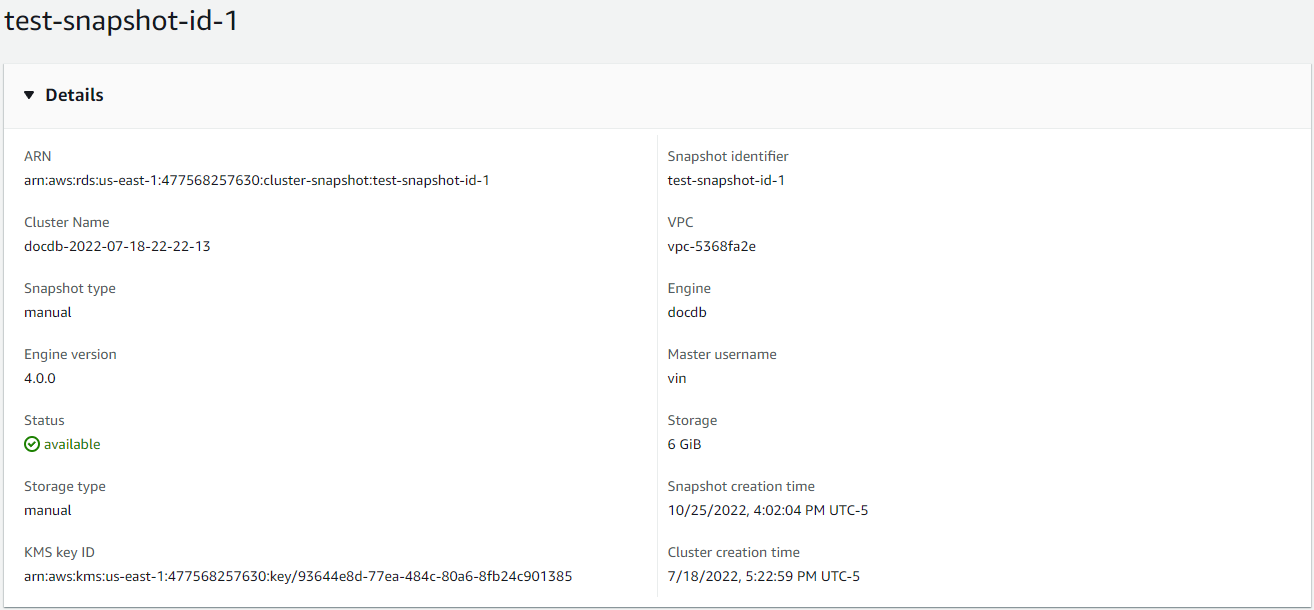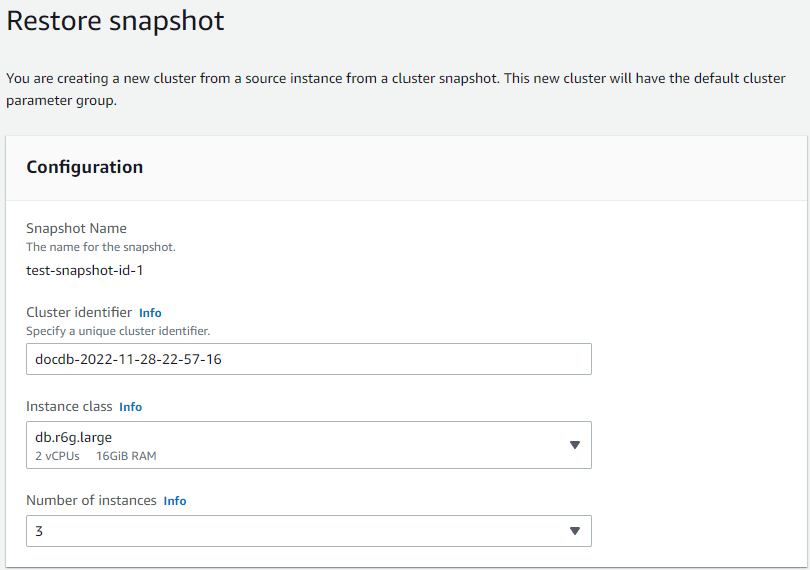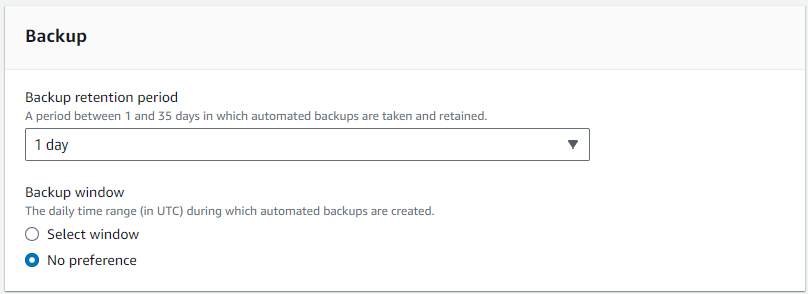Managing elastic cluster snapshots
Manual snapshots can be taken after an elastic cluster has been created. Automated backups are created the moment the elastic cluster snapshot is created.
Note
Your elastic cluster must be in the Available state for a manual snapshot to be taken.
This section explains how you can create, view, restore from, and delete elastic cluster snapshots.
The following topics show how to perform various tasks when working with Amazon DocumentDB elastic cluster snapshots.
Topics
Creating a manual elastic cluster snapshot
In this section we explain how to create a manual elastic cluster snapshot, using either the Amazon Web Services Management Console or Amazon CLI with the following instructions.
- Using the Amazon Web Services Management Console
-
To create a manual elastic cluster snapshot using the Amazon Web Services Management Console:
-
Sign into the Amazon Web Services Management Console
and open the Amazon DocumentDB console. -
In the navigation pane, choose Snapshots.
Tip
If you don't see the navigation pane on the left side of your screen, choose the menu icon in the upper-left corner of the navigation pane.
-
On the Snapshots page, choose Create.
-
On the Create cluster snapshot page, in the Cluster identifier field, choose your elastic cluster from the drop down list.
In the Snapshot identifier field, enter a unique identifier for your elastic cluster.
Choose Create.

Note
Alternatively, you can access the Create cluster snapshot dialog by going to the Clusters page, checking the box next to your cluster, then choosing Actions, then Take snapshot.
Your elastic cluster snapshot is now provisioning. This can take up to a few minutes to finish. You can view and restore from your snapshot when the status shows as
Availablein the Snapshots list. -
- Using the Amazon CLI
-
To create a manual elastic cluster snapshot using the Amazon CLI, use the
create-cluster-snapshotoperation with the following parameters:--snapshot-name—Required. The name of the cluster snapshot you want to create.--cluster-arn—Required. The ARN identifier of the cluster of which you want to create a snapshot.
In the following example, replace each
user input placeholderwith your own information.For Linux, macOS, or Unix:
aws docdb-elastic create-cluster-snapshot \ --snapshot-namesample-snapshot-1\ --cluster-arnarn:aws-cn:docdb:us-west-2:123456789012:sharded-cluster:sample-clusterFor Windows:
aws docdb-elastic create-cluster-snapshot ^ --snapshot-namesample-snapshot-1^ --cluster-arnarn:aws-cn:docdb:us-west-2:123456789012:sharded-cluster:sample-cluster
Viewing an elastic cluster snapshot
In this section we explain how to view elastic cluster snapshot information, using either the Amazon Web Services Management Console or Amazon CLI with the following instructions.
- Using the Amazon Web Services Management Console
-
To view information about a specific elastic cluster snapshot using the Amazon Web Services Management Console:
-
Sign into the Amazon Web Services Management Console
and open the Amazon DocumentDB console. -
In the navigation pane, choose Snapshots.
Tip
If you don't see the navigation pane on the left side of your screen, choose the menu icon in the upper-left corner of the navigation pane.
-
On the Snapshots page, choose your snapshot from the list by clicking on the name in Snapshot identifier column.
-
View your snapshot's information in Details.

-
- Using the Amazon CLI
-
To view information about a specific elastic cluster snapshot using the Amazon CLI, use the
get-cluster-snapshotoperation with the following parameters:--snapshot-arn—Required. The ARN identifier of the snapshot for which you want information.
In the following example, replace each
user input placeholderwith your own information.For Linux, macOS, or Unix:
aws docdb-elastic get-cluster-snapshot \ --snapshot-arnsampleResourceNameFor Windows:
aws docdb-elastic get-cluster-snapshot ^ --snapshot-arnsampleResourceNameTo view information about a specific elastic cluster snapshot using the Amazon CLI, use the
get-cluster-snapshotoperation with the following parameters:--snapshot-arn—Required. The ARN identifier of the snapshot for which you want information.
In the following example, replace each
user input placeholderwith your own information.For Linux, macOS, or Unix:
aws docdb-elastic get-cluster-snapshot \ --snapshot-arnsampleResourceNameFor Windows:
aws docdb-elastic get-cluster-snapshot ^ --snapshot-arnsampleResourceNameTo view information about all elastic cluster snapshots using the Amazon CLI, use the
list-cluster-snapshotsoperation with the following parameters:--snapshot-type—Optional. The type of cluster snapshots to be returned. You can specify one of the following values:automated- Return all cluster snapshots that Amazon DocumentDB has automatically created for your Amazon account.manual- Return all cluster snapshots that you have manually created for your Amazon account.shared- Return all manual cluster snapshots that have been shared to your Amazon account.public- Return all cluster snapshots that have been marked as public.
--next-token—Optional. An optional pagination token provided by a previous request. If this parameter is specified, the response includes only records beyond the this token, up to the value specified bymax-results.--max-results—Optional. The maximum number of results to include in the response. If more results exist than the specifiedmax-resultsvalue, a pagination token (next-token) is included in the response so that the remaining results can be retrieved.Default: 100
Minimum 20, maximum 100
In the following example, replace each
user input placeholderwith your own information.For Linux, macOS, or Unix:
aws docdb-elastic list-cluster-snapshots \ --snapshot-typevalue\ --next-tokenvalue\ --max-results50For Windows:
aws docdb-elastic list-cluster-snapshots ^ --snapshot-typevalue^ --next-tokenvalue^ --max-results50
Restoring an elastic cluster from a snapshot
In this section we explain how to restore an elastic cluster from a snapshot, using either the Amazon Web Services Management Console or Amazon CLI with the following instructions.
- Using the Amazon Web Services Management Console
-
To restore an elastic cluster from a snapshot using the Amazon Web Services Management Console:
-
Sign into the Amazon Web Services Management Console
and open the Amazon DocumentDB console. -
In the navigation pane, choose Snapshots.
Tip
If you don't see the navigation pane on the left side of your screen, choose the menu icon in the upper-left corner of the navigation pane.
-
Choose the button to the left of the snapshot, that you want to use to restore a cluster, in the Snapshot identifier column.
-
Choose Actions, then Restore.

-
On the Restore snapshot page, enter a name for the new cluster in the Cluster identifier field.
Note
For any manual snapshot restoration, you must create a new cluster.
-
In the Virtual Private Cloud (VPC) field, choose a VPC from the drop-down list.
-
For Subnets and VPC security groups, you can use the defaults or select three subnets of your choice and upto three VPC security groups (minimum one).
-
If you are satisfied with the cluster configuration, choose Restore cluster and wait while your cluster is restored.
-
- Using the Amazon CLI
-
To restore an elastic cluster from a snapshot using the Amazon CLI, use the
restore-cluster-from-snapshotoperation with the following parameters:--cluster-name—Required. The current name of the elastic cluster as entered during creation or last modified.--snapshot-arn—Required. The ARN identifier of the snapshot being used to restore the cluster.--vpc-security-group-ids—Optional. One or more Amazon EC2 and Amazon Virtual Private Cloud (VPC) security groups to associate with the cluster.--kms-key-id—Optional. Configure the KMS key identifier for an encrypted cluster.The KMS key identifier is the Amazon Resource Name (ARN) for the Amazon KMS encryption key. If you are creating a cluster using the same Amazon Web Services account that owns the KMS encryption key that is used to encrypt the new cluster, you can use the KMS key alias instead of the ARN for the KMS encryption key.
If an encryption key is not specified in KmsKeyId and if the
StorageEncryptedparameter is true, Amazon DocumentDB uses your default encryption key.--subnet-ids—Optional. Network subnet Ids.
In the following example, replace each
user input placeholderwith your own information..For Linux, macOS, or Unix:
aws docdb-elastic restore-cluster-from-snapshot \ --cluster-nameelastic-sample-cluster\ --snapshot-arnsampleResourceName\ --vpc-security-group-ids valueec-65f40350\ --kms-key-idarn:aws:docdb-elastic:us-east-1:477568257630:cluster/b9f1d489-6c3e-4764-bb42-da62ceb7bda2\ --subnet-idssubnet-9253c6a3, subnet-9f1b5af9For Windows:
aws docdb-elastic restore-cluster-from-snapshot ^ --cluster-nameelastic-sample-cluster^ --snapshot-arnsampleResourceName^ --vpc-security-group-ids valueec-65f40350^ --kms-key-idarn:aws-cn:docdb-elastic:us-east-1:477568257630:cluster/b9f1d489-6c3e-4764-bb42-da62ceb7bda2^ --subnet-idssubnet-9253c6a3, subnet-9f1b5af9
Copying an elastic cluster snapshot
In Amazon DocumentDB, you can copy manual and automatic elastic cluster snapshots within the same region and within the same account. In this section we explain how to copy an elastic cluster snapshot, using either the Amazon Web Services Management Console or Amazon CLI.
- Using the Amazon Web Services Management Console
-
To copy an elastic cluster snapshot using the Amazon Web Services Management Console:
-
Sign into the Amazon Web Services Management Console
and open the Amazon DocumentDB console. -
In the navigation pane, choose Snapshots.
Tip
If you don't see the navigation pane on the left side of your screen, choose the menu icon in the upper-left corner of the navigation pane.
-
Choose the button to the left of the snapshot, that you want to copy, in the Snapshot identifier column.
-
Choose Actions, then Copy.

-
For New snapshot identifier, enter the new snapshot's name.
-
For Copy Tags, check the box if you want to copy all tags from the source elastic cluster snapshot to the target elastic cluster snapshot.
-
For Encryption, choose either a default Amazon KMS key or a KMS key of your choosing. The second option allows you to select an existing KMS key that you already created or allows you to create a new one.
-
Choose Copy snapshot when complete.
-
- Using the Amazon CLI
-
To copy an elastic cluster snapshot using the Amazon CLI, use the
copy-cluster-snapshotoperation with the following parameters:‐‐source-db-cluster-snapshot-identifier—Required. The identifier of the existing elastic cluster snapshot being copied. The elastic cluster snapshot must exist and be in the available state. This parameter is not case sensitive.‐‐target-db-cluster-snapshot-identifier—Required. The identifier of the new elastic cluster snapshot to create from the existing cluster snapshot. This parameter is not case sensitive.Target snapshot name constraints:
Cannot be the name of an existing snapshot.
Length is [1—63] letters, numbers, or hyphens.
First character must be a letter.
Cannot end with a hyphen or contain two consecutive hyphens.
In the following example, replace each
user input placeholderwith your own information.For Linux, macOS, or Unix:
aws docdb-elastic copy-cluster-snapshot \ ‐‐source-cluster-snapshot-arn<sample ARN>\ ‐‐target-cluster-snapshot-namemy-target-copied-snapshotFor Windows:
aws docdb-elastic copy-cluster-snapshot ^ ‐‐source-cluster-snapshot-arn<sample ARN>^ ‐‐target-cluster-snapshot-namemy-target-copied-snapshot
Deleting an elastic cluster snapshot
In this section we explain how to delete an elastic cluster snapshot, using either the Amazon Web Services Management Console or Amazon CLI.
- Using the Amazon Web Services Management Console
-
To restore an elastic cluster from a snapshot using the Amazon Web Services Management Console:
-
Sign into the Amazon Web Services Management Console
and open the Amazon DocumentDB console. -
In the navigation pane, choose Snapshots.
Tip
If you don't see the navigation pane on the left side of your screen, choose the menu icon in the upper-left corner of the navigation pane.
-
Choose the button to the left of the snapshot, that you want to use to restore a cluster, in the Snapshot identifier column.
-
Choose Actions, then Delete.

-
On the Delete "snapshot-name" snapshot dialog, choose Delete.
-
- Using the Amazon CLI
-
To delete an elastic cluster snapshot using the Amazon CLI, use the
delete-cluster-snapshotoperation with the following parameters:--snapshot-arn—Required. The ARN identifier of the snapshot being used to restore the cluster.
In the following example, replace each
user input placeholderwith your own information..For Linux, macOS, or Unix:
aws docdb-elastic delete-cluster-snapshot \ --snapshot-arnsampleResourceNameFor Windows:
aws docdb-elastic delete-cluster-snapshot ^ --snapshot-arnsampleResourceName
Managing an elastic cluster snapshot automatic backup
Amazon DocumentDB takes daily snapshots of your elastic clusters. You can specify the preferred backup window and the backup retention period in a new or existing elastic cluster snapshot configuration. In this section we explain how to set automatic backup parameters in an elastic cluster snapshot, using either the Amazon Web Services Management Console or Amazon CLI.
- Using the Amazon Web Services Management Console
-
To set an automatic backup for a new elastic cluster snapshot using the Amazon Web Services Management Console:
-
Sign into the Amazon Web Services Management Console
and open the Amazon DocumentDB console. -
In the navigation pane, choose Clusters.
Tip
If you don't see the navigation pane on the left side of your screen, choose the menu icon in the upper-left corner of the navigation pane.
-
Choose the button to the left of the cluster, that you want to change the backup settings for, in the Cluster identifier column.
-
Choose Actions, then Modify.
-
In the Backup section, edit the fields according to your backup requirements.

-
Backup retention period—In the list, choose the number of days to keep automatic backups of this cluster before deleting them.
-
Backup window—Set the daily time and duration during which Amazon DocumentDB is to make backups of this cluster.
-
Choose Select window if you want to configure the time and duration when backups are created.
Start time—In the first list, choose the start time hour (UTC) for starting your automatic backups. In the second list, choose the minute of the hour that you want automatic backups to begin.
Duration—In the list, choose the number of hours to be allocated to creating automatic backups.
-
Choose No preference if you want Amazon DocumentDB to choose the time and duration when backups are created.
-
-
-
Choose Modify cluster when complete.
-
- Using the Amazon CLI
-
To set an automatic backup for a new elastic cluster snapshot using the Amazon CLI, use the
create-cluster-snapshotoperation with the following parameters:--preferred-backup-window—Optional. The daily preferred time range during which automated backups are created. The default is a 30-minute window selected at random from an 8-hour block of time for each Amazon Web Services Region.Constraints:
Must be in the format
hh24:mi-hh24:mi.Must be in Universal Coordinated Time (UTC).
Must not conflict with the preferred maintenance window.
Must be at least 30 minutes.
--backup-retention-period—Optional. The number of days for which automated backups are retained. The default value is 1.Constraints:
Must specify a minimum value of 1.
Range is from 1 to 35.
Note
Automated backups are only be taken when the cluster is in an ‘active’ state.
Note
You can also modify the
preferred-backup-windowandbackup-retention-periodparameters of an existing elastic cluster using theaws docdb-elastic update-clustercommand.In the following example, replace each
user input placeholderwith your own information.The following
create-clusterexample creates the Amazon DocumentDB elastic clustersample-clusterwith the retention period for automatic backups of7days, and a preferred backup window of18:00-18:30 UTC.For Linux, macOS, or Unix:
aws docdb-elastic create-cluster \ --cluster-namesample-cluster\ --shard-capacity2\ --shard-count2\ --admin-user-nameSampleAdmin\ --auth-type PLAIN_TEXT \ --admin-user-passwordSamplePass123!\ --preferred-backup-window18:00-18:30\ --backup-retention-period7For Windows:
aws docdb-elastic create-cluster ^ --cluster-namesample-cluster^ --shard-capacity2^ --shard-count2^ --admin-user-nameSampleAdmin^ --auth-type PLAIN_TEXT ^ --admin-user-passwordSamplePass123!^ --preferred-backup-window18:00-18:30^ --backup-retention-period7